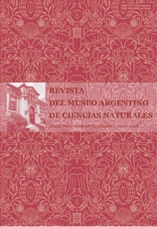A new species group and two new species of freyine jumping spiders (Araneae, Salticidae, Aelurillini)
Resumen
Palabras clave
Texto completo:
PDF (English)Referencias
Edgar, R.C. 2004. MUSCLE: multiple sequence alignment with high accuracy and high throughput. Nucleic Acids Research 32: 1792-1797. pmid:15034147
Edwards, G.B. 2015. Freyinae, a major new subfamily of Neotropical jumping spiders (Araneae: Salticidae). Zootaxa 4036(1): 1-87. doi.org/10.11646/zootaxa.4036.1.1
Felsenstein, J. 1985. Confidence limits on phylogenies: An approach using the bootstrap. Evolution 39: 783-791.
Folmer, O., Hoeh, W.R., Black, M.B. & R.C. Vrijenhoek. 1994. Conserved primers for PCR amplification of mitochondrial DNA from different invertebrate phyla. Molecular Marine Biology and Biotechnology 3: 294-299.
Galiano, M.E. 1981a. Revisión del genero Phiale C. L. Koch, 1846 (Araneae, Salticidae) III. Las especies polimórficas del grupo mimica. Journal of Arachnology 9: 61-85.
Galiano, M.E. 1981b. Revision of the genus Phiale C. L. Koch, 1846 (Araneae, Salticidae). IV. The polymorphic species of the gratiosa group. Bulletin of the British Arachnological Society 5: 205-216.
Galiano, M.E. 1984. Descripción de Wedoquella nuevo género (Araneae, Salticidae). Journal of Arachnology 11: 343-352.
Ivanova, N.V., Dewaard, J.R. & P.D.N. Hebert. 2006. An inexpensive automation-friendly protocol for recovering high-quality DNA. Molecular Ecology Notes 6(4): 998-1002.
Kimura, M. 1980. A simple method for estimating evolutionary rate of base substitutions through comparative studies of nucleotide sequences. Journal of Molecular Evolution 16: 111-120.
Koch, C.L. 1846. Die Arachniden. Dreizehnter Band, Nürnberg.
Kumar, S., Stecher, G., Li, M., Knyaz, C. & K. Tamura. 2018. MEGA X: Molecular Evolutionary Genetics Analysis across computing platforms. Molecular Biology and Evolution 35: 1547-1549.
Levi, H.W. 1965. Techniques for the study of spider genitalia. Psyche 72: 152-158.
Maddison, W.P. 2015. A phylogenetic classification of jumping spiders (Araneae: Salticidae). Journal of Arachnology 43(3): 231-292. doi.org/10.1636/arac-43-03-231-292
Peckham, G.W. & E.G. Peckham. 1896. Spiders of the family Attidae from Central America and Mexico. Occasional papers of the Natural History Society of Wisconsin 3: 1-101.
Saitou, N. & M. Nei. 1987. The neighbor-joining method: A new method for reconstructing phylogenetic trees. Molecular Biology and Evolution 4: 406-425.
Tamura, K. & M. Nei. 1993. Estimation of the number of nucleotide substitutions in the control region of mitochondrial DNA in humans and chimpanzees. Molecular Biology and Evolution 10: 512-526.
Wilson, J.J. 2012. DNA barcodes for insects. In Kress W.J. & D.L. Erickson (eds.). DNA barcodes: Methods and protocols, pp. 17-46, Springer.
Enlaces refback
- No hay ningún enlace refback.

This work is licensed under a Creative Commons Attribution 3.0 License.

